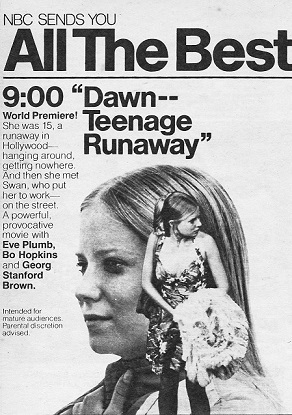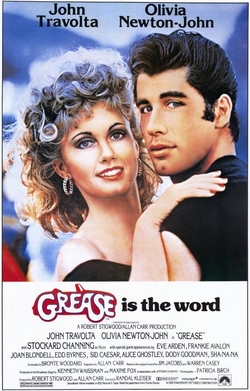Welcome to Retro Television Reviews, a feature where we review some of our favorite and least favorite shows of the past! On Sundays, I will be reviewing the made-for-television movies that used to be a primetime mainstay. Today’s film is 1976’s Dawn: Portrait of a Teenage Runaway! It can be viewed on YouTube!
Dawn Wetherby (Eve Plumb) is fifteen years old. She’s naive. She’s innocent. She’s …. well, let’s just be honest and admit that she’s not particularly bright. Sick of being embarrassed by her alcoholic mom (Lynn Carlin), Dawn decides to hop on a bus and travel to Hollywood. Maybe she can make a new life for herself in California.
Of course, it doesn’t take long for Dawn to discover that Los Angeles is not a city where dreams magically come true. It’s a tough and harsh town and it’s not like Dawn has any money or any particular skills. When she tries to get a job, she’s told that she’s too young. When she tries to rent a room, she’s told that ten dollars is not enough to cover two weeks rent. When she gives a dollar to a boy who says that he needs it, he responds by mugging her for the rest of her cash. A prostitute named Frankie Lee (Marguerite DeLain) takes some sympathy on Dawn and tells her to call if she ever wants to make some money.
Eventually, a nasty cough leads to Dawn going to the free clinic. That’s where she meets Alexander (Leigh McCloskey). Alexander is a teen runaway, just like Dawn. However, Alexander also can somehow afford an apartment and food to eat. Alexander invites Dawn to live with him and Dawn, realizing she has no where else to go, agrees. Alexander offers to look after her but, after Dawn discovers that Alexander makes his money by working as a male prostitute, Dawn decides that she needs a job of her own.
It’s time to call Frankie Lee! And it’s time for Frankie Lee to introduce Dawn to Swan (Bo Hopkins), a pimp who lives in a nice house and who offers to put Dawn to work….
Dawn: Portrait of a Teenage Runaway is an earnest film that was obviously made with the best of intentions and which actually did have something say, in its melodramatic way, about the dangers of running away from home and trying to make it on your own when you’re not even old enough to drive. That said, I imagine that most people who go through the effort to track down this film will do so because it stars The Brady Bunch‘s Eve Plumb as an underage runway who ends up walking the streets and taking men back to her motel room. The movie might as well be called Jan Brady Goes Bad, because Eve Plumb does essentially give the same performance that she gave when she was playing the whiniest member of the Brady Bunch. There’s nothing tough or streetwise about her, which works for the first half of the film but not during the second half. Once Dawn has been on the streets for a bit, you would expect her to toughen up a bit but she still comes across like she’s mad at Greg and Bobby for tying up the phone. Dawn goes through a lot and becomes a bit jaded as a result but, every time she speaks, you expect her to exclaim, “Why does Marcia get to runaway from home but I don’t? It’s not fair!” Far more impressive are the performances of Bo Hopkins and, in the role of Dawn’s probation officer, George Stanford Brown. William Schallert also has a good bit as Dawn’s first client, who ends up feeling so sorry for Dawn that he just give her twenty dollars and then tells her to go back home.
Dawn: Portrait of a Teenage Runway is one of those film that was obviously designed to make parents worry about their kids. It seems to be asking, “Do you know where your children are tonight?” In 1976, I imagine they were busy watching Jan Brady try to make it on the mean streets of Hollywood.




